
|
Sale 81
The Pre-Long Beach Sale
| Lot |
Photo |
Description |
Realized |
Lot 869 |
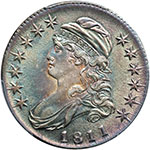 |
1811. Small 8. O-108a, Rarity-2. PCGS graded AU-58. Frosty with nice blue obverse toning. Late die state with interesting reverse die breaks per Overton (PCGS # 6097) .
Estimated Value $600 - 650.
View details and enlarged photos
Check results on similar lots
| Realized
$2,820 |
Lot 870 |
 |
1812. PCGS graded EF-40. Even gray toning (PCGS # 6100) .
Estimated Value $200 - 220.
View details and enlarged photos
Check results on similar lots
| Realized
$441 |
Lot 871 |
 |
1815. 5 over 2 Sharpness of AU-55. We note a moderate old scratch in the left obverse field. Nice light blue toning. Popular date. A high degree of detail distinguishes the medium silver gray surfaces from others of the date which are less original even though in technically similar grade. Collectors familiar with the series will recognize this difference at once and will especially note the sharp cap, hair curls, and drapery clasp on the obverse. The reverse, for its part, continues the bold attraction. Everything on this side shows its finer detail. A desirable Key date, even in light of the obverse mark.
On January 11, 1816, a fire in the rear building of the Mint damaged rolling and cutting apparatus sufficiently to make any further coinage of gold or silver impossible until extensive repairs could be made.
Regarding the damage to the rolling and cutting apparatus, while this affected the Mint planchet preparation process, the real reason for lack of half dollar coinage after 1815 was lack of deposits. The War of 1812 had officially ended on December 24, 1814, but news of this was not fully disseminated until well into 1815 (the Battle of New Orleans, showcasing the heroism of Andrew Jackson, took place in January 1815 after the war had ended). The commerce of Europe remained in turmoil, affected not only by the aftermath of the War of 1812, but also the recent wider-ranging Napoleonic Wars (PCGS # 6108) .
Estimated Value $2,500 - 3,000.
View details and enlarged photos
Check results on similar lots
| Realized
$7,344 |
Lot 872 |
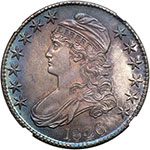 |
1826. NGC graded MS-66. Lovely gold and blue toning. This coin must be one of the most attractive Mint State 1826 Half Dollars extant. The coin displays layer upon layer of rich, deep magenta and blue toning spanning the surface, with golden accents, and all iridescence at a few angles; mesmerizing if one stares at it too long. The reverse impression is as expertly centered and preserved as the obverse, and it has been brought up bold by the dies. All features, neck feathers, talons, scroll, the shield "chief" (that being the horizontal lines at the top) and everything in-between is clearly displayed. The obverse couldn�t be better produced, either. Even if a critic were to get on his high horse and argue about something, there is nothing to argue over, the coin is sure-fire bold on every direction. This includes full stars. One of the most gorgeous specimens we have seen in a long time. A coin that calls out for inclusion in an advanced collection of Capped Bust Halves. Pop 18; 7 finer, 1 in 66 Star, 1 in 66+, 5 in 67.
Estimated Value $10,000 - 11,000.
View details and enlarged photos
| Realized
$12,338 |
Lot 873 |
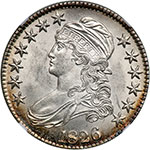 |
1826. NGC graded MS-65. A nice white well struck coin. There is little to say about the surfaces of this 1826 Capped Bust Half Dollar as they are as near to perfect for such an early specimen as imaginable. The mint frost is thick. It radiates. There is a surreal intensity over each side. Nature has put a bit of light patina present as well, around the rim on both sides. Probably a good many are nowhere near as carefully struck as this 1826, with no suggestion or even a whisper of weakness at the main design features. We can describe them for you, individually, but what is the point. The coin is fantastic in terms of its sharp relief. Zoom in on the photographs if you are viewing this Lot online. You will be delighted as we are by this coin's resplendence! Among Mint State Half Dollars of this vintage, only a few in existence today could seriously challenge the Gem offered here. Pop 57; 26 finer, 1 in 65 Star, 18 in 66, 1 in 66 Star, 1 in 66+ Star, 5 in 67.
Estimated Value $7,000 - 7,500.
View details and enlarged photos
| Unsold |
Lot 874 |
 |
1826. Sharpness of AU-55. Blundered edge "FIFTY NTS".
Estimated Value $300 - 350.
View details and enlarged photos
| Realized
$470 |
Lot 875 |
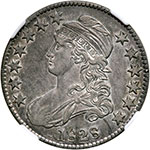 |
1828. Square base 2. NGC graded AU-53. Light grey and blue toning.
Estimated Value $325 - 350.
View details and enlarged photos
| Realized
$423 |
Lot 876 |
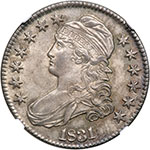 |
1831. NGC graded MS-65. Nice even toning on both sides. For the date, a frosty, satiny toned gem with smooth almost cartwheel luster on both sides. Attractively struck as well, with just a hint of softness at the stars and reverse branch stem. Pop 49; 16 finer, 14 in 66, 2 in 67.
Historic Note concerning this design: After Robert Scot died in 1823, aged 79, his replacement William Kneass took charge of day to day coinage activity. Kneass had the same assignment as John Reich, when he was employed at the Mint: Improve existing designs in all denominations (Scot had replaced the Reich device punches with inferior copies of his own). Kneass, however, did not get around to the half dollars for over a decade. He did complete several device punches, beginning in 1824, but they differed only minutely from those already in use. (On the other hand, during Scot's last six years, the half dollars featured about a dozen overdate dies, whereas during Kneass's first six years, the denomination showed only five overdates, which the Mint might have seen as an improvement.)
Numeral and letter punches during the early 1820s were furnished by Henry Starr; after about 1824, by Christian Gobrecht, the inventor, mechanical genius, medallist, and bank-note-plate engraver who would eventually to replace Kneass after the latter suffered a stroke in 1835
Edge devices differ minutely from one year to the next on Bust Half Dollars; sometimes several were in use during the same year. Unfortunately, the advent of the first few generations of grading holders obscure the important edge variances on these large coins.
Breen reports in his encyclopedia, "Tens or hundreds of thousands of specimens 1809-36 went directly to banks, which retained them as part of their cash reserves, long after new laws mandated smaller sizes and lower weights. These coins came to public attention about 1933-34, when Pres. Roosevelt's bank holiday resulted in exhaustive searches of many cashiers' vaults. Others showed up during the same period owing to bank failures, still others from hoarders' estates. Before then, the biggest single source was probably the Economite hoard (buried by the New Harmony Society, Economy, Pa., and discovered in 1878). This contained 111,356 bust half dollars, many close to mint state but scrubbed--including 100 1815s. For this reason, many varieties of this design come mostly in VF to AU, "sliders" (slightly rubbed coins being masqueraded as "UNCIRCULATED") being common. However, truly mint-state specimens of any date before 1836 are difficult to find, far more so if sharp strikings.".
Estimated Value $6,000 - 6,500.
View details and enlarged photos
| Unsold |
Lot 877 |
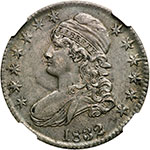 |
1832. NGC graded AU-55. Nice old time toning with lustrous fields and devices.
Estimated Value $450 - 500.
View details and enlarged photos
| Realized
$558 |
Lot 878 |
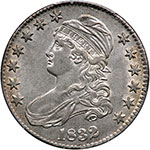 |
1832. Small Letters. Overton-111, Rarity 1. PCGS graded AU-55. Frosty with a hint of tone on this lustrous example (PCGS # 39869) .
Estimated Value $350 - 400.
View details and enlarged photos
Check results on similar lots
| Realized
$458 |
Lot 879 |
 |
1833. Overton-107, Rarity 3. NGC graded MS-66. Very Frosty and nicely toned. An astounding beauty and a first-rate gem! The satiny surfaces are smooth, glowing with full volatile cartwheel luster that looks as though it would like nothing better than to race around the surface like a young thoroughbred colt does when first let out into his pasture. Well struck for the date also. This 1833 easily matching or surpassing other MS66 examples in the Bust Half Dollar series.
A sixth stylistic change was made to John Reich's Capped Bust left Half Dollar in 1832, and was used on coins struck from 1832 to 1834. Here, the relief levels of the entire design were visibly raised; curls were made finer and thinner (but coarsening gradually in 1833 and 1834). Also, Liberty's profile was substantially altered. Throughout the 1807 to 1836 Bust Half Dollar run, the mint constantly tinkered with the designs. One sees sharpening here, raising or lowering the relief there; the workmen punching things into the dies tested different sizes of star or letter punches, different date punches, curved base 2, square base 2, knob on 2, no knob on 2, that sort of thing. It is all very confusing. But intriguing. Each year has its own personality, not to put too anthropomorphic a spin on the discussion. And within each year, a subset of quite often fascinating die varieties.
Take Overton-107 for instance, as described in the 4th Edition Parsley/Overton Half Dollar die variety book. This coin. In the O-107 description, Mr. Parsley or Mr. Overton tells us the date has "1 over 1, droopy base." Now what a demeaning thing to say! Droopy base. The nerve. Meaning, we suppose, that it slants down a bit on the right side. Then, on the reverse, "many stripe lines extend below the shield." That didn�t happen all by itself. Someone made it happen. Was this done as a gag? Or did the boss walk in just as the engraver was strengthening his shield stripes, and inadvertently let slip his wrist while hoping to hear that they were finally giving him his promised Christmas bonus? (Mint workers in those days also received a daily beer ration. Yes, a beer ration. Fancy that. Could it be Overton-107's die engraver asked for one too many refills? We�ll never know. Only the evidence remains: "many stripe lines extend below the shield.") Pop 1; none finer at NGC.
Estimated Value $11,000 - 12,000.
View details and enlarged photos
| Unsold |
Lot 880 |
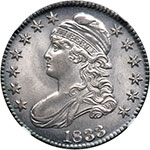 |
1833. NGC graded MS-65. Frosty and mostly untoned. A satiny white gem with strong underlying luster. Well struck with full stars except for three that come a little rounded; devices are satisfyingly close enough to full that mention is merited. We have seen many instances of the 1833 where E PLURIBUS on the ribbon is flat to nonexistent due to its location opposite Liberty's ample breasts on the obverse. The motto simply could not compete. Indeed, the strike of the present coin easily rivals that of the higher numerical grade coins graded by the two main services.
Upon his appointment to the position of chief engraver in 1824, William Kneass was initially tasked with refining the coinage designs then in use by the United States Mint. In 1832, he put his hand to John Reich's Capped Bust Half Dollar. Examples differ from earlier-dated pieces chiefly in the fine points of Liberty's bust. Thanks to Kneass' work, extant 1832 Halves display the bust in higher relief, finer hair curls, a more rounded cheek and a slightly altered profile.
Throughout virtually its entire production run, the Capped Bust Half Dollar with Lettered Edge (1807-36) was the largest silver coin being struck in the United States. It should come as no surprise to read, therefore, that this was the preferred denomination of contemporary banks and other bullion depositors. Most issues in this series have respectable mintages, and survivors can be found in circulated to lower Mint State grades without ease. Examples that grade higher than MS63 are, however, scarce-to-rare from a standpoint of market availability.
The relatively high mintage posted for most Lettered Edge Capped Bust Halves required a sizeable number of working dies. As such, this series is perhaps the most widely pursued in all of U.S. numismatics where variety specialists are concerned. Many 1833 die marriages are plentiful in an absolute sense, but some are significant, highly respected rarities.
This type was designed originally by John Reich (born Johann Matthaus Reich), a German who sold himself into indentured servitude in the United States to escape the ravages of the Napoleonic Wars. Reich first come to prominence as an engraver in 1801, but opposition from then-Chief Engraver Robert Scot delayed his appointment as Assistant Engraver until 1807. The Capped Bust, Lettered Edge Half Dollar is widely regarded as Reich's most instantly recognizable and enduring contribution to the U.S. coinage family. Pop 28; 9 finer, 1 in 65 Star, 5 in 66, 2 in 67, 1 in 68.
Estimated Value $7,500 - 8,000.
View details and enlarged photos
| Unsold |
Lot 881 |
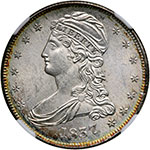 |
1837. NGC graded MS-65. A hint of gold tone around the edges. Frosty, mostly untoned and well struck. Fabulous quality and overall surfaces. The coin has blazing white mint luster and is virtually abrasion-free. At best, it is not easy to find such luster. So too crisp definition on the main devices counts for a lot. Mathematically exact standards are seen in the sharp devices.
Of the two-year Half Dollars struck on the Mint's new steam operated press, the 1836-37 FIFTY CENTS issue has a much more modern look than its 1807-36 predecessor. The first-year 1836 is rare and expensive; the second year 1837 the more readily obtainable of the four issues in the short-lived Reeded Edge Half Dollar series of 1836-39 in which the denomination is expressed as first FIFTY CENTS and then HALF DOL. along the lower-reverse border. This 1837 is still a scarce issue in an absolute sense, however, and Mint State 65 survivors are downright rare from the standpoint of market availability. A grossly underrated issue in high grades.
The introduction of a steam coinage press in the Philadelphia Mint in 1836 occasioned a replacement for the venerable lettered edge, Capped Bust Half Dollar. Assistant Engraver Christian Gobrecht reworked the design to include a sharper, more refined appearance to Liberty's portraiture on the obverse and a new reverse eagle. He also removed the scroll that used to reside in the upper-reverse field and upon which the Latin motto E PLURIBUS UNUM was inscribed.
The steam press allowed the U.S. Mint to start using a "close collar" to produce coins of this denomination as opposed to the older "open collar," and some of Gobrecht's modifications to the Capped Bust Half Dollar were also made to accommodate this innovative piece of equipment. Most significant in this regard are a beaded border and a pronounced raised rim. Since the lettering that appears on the edges of Capped Bust Halves from 1807-1836 was imparted prior to striking, and the close collar exerted tremendous pressure when the coins were struck, edge lettering could no longer be used. Instead, Half Dollars came out of the press with a reeded edge. The modified Capped Bust examples of 1836-1839 are usually referred to as the Reeded Edge type for this reason. Pop 41; 16 finer at NGC.
Estimated Value $12,000 - 13,000.
View details and enlarged photos
| Unsold |
Lot 882 |
|
A lot of Capped Bust Half Dollars. Consists 1810, 1826, 1833, 1834, and 1835. Coins will grade VF to EF. Lot of 5 coins.
Estimated Value $500 - 550.
View details
| Realized
$588 |
Lot 883 |
|
A pair of PCGS graded Capped Bust Half Dollars. Consist of: 1826, XF Details, Cleaning; 1837, AU Details, Cleaning. Both nicely toned. Lot of 2 coins.
Estimated Value $150 - 200.
View details
| Realized
$329 |
|
|